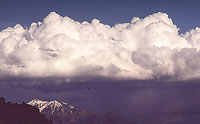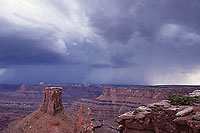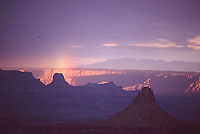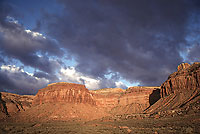A perfectly acceptable summer pastime in Canyon Country is to watch the progression of clouds build up during the day and drift across the redrock landscape. August represents prime cloud watching time as the summer monsoon season settles in.
Watching summer “cloudscapes” can also be beneficial in terms of understanding weather patterns and avoid getting caught out in thunderstorms. There is nothing more spectacular and dangerous at the same time as a summer storm sweeping across the landscape, multiple jags of lightning electrifying the sky.
But of course, there is more to this story than just a cloud-studded sky.
This story starts with a young English lad named Luke Howard. A bit of a daydreamer, he watched clouds as a young boy growing up in London in the late 1770s.
 His practical father thought this activity a waste of time so he sent young Luke to a Quaker boarding school where the schoolmaster demanded perfection from his students in the study of Latin, and other subjects.
His practical father thought this activity a waste of time so he sent young Luke to a Quaker boarding school where the schoolmaster demanded perfection from his students in the study of Latin, and other subjects.
Daily repetitions and reciting of Latin words such as nube – by a cloud, nubes – a cloud, nubis – of a cloud were not lost on the quick learner. Luke finished school at age 16 and became apprenticed to a Quaker chemist for the next six years. His move from London to the countryside chemical factory reunited him with his first love – watching the sky.
With the zeal of science fresh on his mind, Luke recorded daily weather conditions and sketched the clouds. He understood that certain cloud formations were associated with particular weather. Of course, there was no Weather Channel or even a standardization of names by which to call these clouds. 
By 1802, Luke had been studying clouds and joined a scientific club called the Askesian Society that was made up all people from various walks of life who were observant about nature, mechanics or chemistry to name but a few subjects. Luke read his essay “The Modification of Clouds” (back then “modification” meant “classification”) to the organization. He described how clouds formed, their foretelling of weather patterns and proposed a classification system similar to the one Carl Linnaeus created for plants in 1735.
Luke used Latin names to identify three main types of clouds: cirrus (curl of hair), cumulus (heap) and stratus (layer). He further defined names for particular cloud types such as cirrostratus, cumulostratus, cirrocumulus, and nimbus, which meant “rain.” Finally, a language for naming clouds!

Luke’s system was printed in a scientific magazine in 1803, and became the popular nomenclature for clouds. Over the years, there have been changes to his system, but still many of the terms are in use today.
If Luke Howard had lived in the Southwest he might have coined the word “virga,” a Latin word meaning “twig” or “branch” and referring to those streaks that hang from the underbelly of a thunderhead, like tentacles or wisps of smoke, and where raindrops evaporate before they hit the ground. Though common on a hot summer day, these formations foretell the promise of rain and relief from the August heat.
Luke Howard died in 1864 and outside his historic home in Tottenham, England hangs a simple sign that reads: the Namer of Clouds. That is a title I’m sure he would have been proud of.


 His practical father thought this activity a waste of time so he sent young Luke to a Quaker boarding school where the schoolmaster demanded perfection from his students in the study of Latin, and other subjects.
His practical father thought this activity a waste of time so he sent young Luke to a Quaker boarding school where the schoolmaster demanded perfection from his students in the study of Latin, and other subjects.
